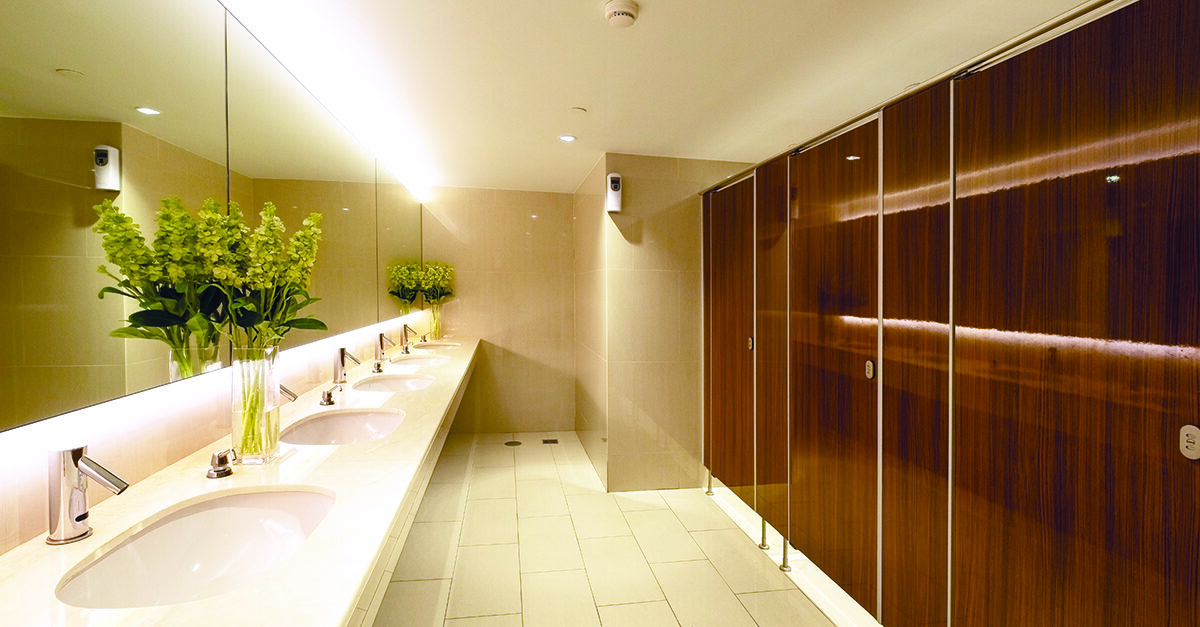Every year, it seems like there’s a high-tech restroom care solution that makes the industry rethink the way restrooms are cleaned. While many of these solutions are innovative and can save money and time, there are certain essential truths about restroom care that will never change.
According to the 2022 Healthy Handwashing Survey from Bradley Corporation, almost 60% of Americans say they are likely to spend more money at a business with clean, well-maintained restrooms. Restroom care matters now more than ever before. In this article, we dig into some of the real truths about restroom care, share the little-known facts we learned from cleaning industry experts, and dispel common restroom care myths.
How often should you really disinfect a toilet?
In a perfect world, we would be right there to clean the toilet or urinal after every use. But who has time to do that? Plus, that would make building occupants a little uncomfortable. Facility teams
must strike the perfect balance between acceptable frequencies and the risk of contamination. We asked a few experts to weigh in on the recommended disinfection frequencies for toilet seats, as well as other high-touch restroom surfaces. They all agreed that the answer depended on traffic, but disinfection is performed certainly more often than ever before.
“What used to be considered appropriate and adequate at once a day has changed in the post-COVID-19 era,” says Mark Warner, national sales manager at Bullen, a manufacturer of specialty
cleaning products. “COVID changed all the rules. Our habits and frequencies have gotten much more intense and it will probably
never go back to what they used to be.”
Joel Craddock, president of Doc’s Facilities Solutions, determines restroom surface cleaning frequencies based on occupants, total restrooms, and total amount of a specific surface (for example, number of toilets in each restroom). As a building service contractor (BSC) owner, Craddock says new clients often ask him to clean an office restroom only two or three times a week.
“When I hear that, I always ask them how many people are in the facility before I can give them an answer,” says Craddock. “Then I do the math. If 100 people work in a building, that means they
will each use a restroom four times during a typical eight-hour shift. That means the restroom is being used 400 times in those eight hours. And when we look at those numbers, the frequencies
for disinfecting and cleaning high-touch surfaces will become a lot clearer.”
There is no hard and fast rule for how frequently you should disinfect a toilet, or any high-touch restroom surface. The answer must take into account the amount of traffic in the building
compared with the amount of toilets and surfaces available to people. It is clear, however, that COVID-19 has increased public demand for more frequent restroom cleaning. Pro-tip: “It’s not a bad idea to invest in some signage or indicators that communicate to the public how often the restroom has been cleaned in a day,” says Warner.
What is the most overlooked surface in a restroom?
One little-known fact those in the know about restroom care agree on: The most often overlooked surface in any restroom is the latch inside the stall. Nearly everyone who uses a restroom touches this small fixture, and yet most restroom care procedures ignore it.
“If you’re in the stall, what’s the last thing you touch before you leave?” asks Craddock. “The back latch is the dirtiest part of the restroom. Proper training protocols need to emphasize the back latch. Some companies will use an ATP (adenosine triphosphate) meter, which will test the amount of bio particles on a surface, and this can be used to reinforce these procedures.”
New imaging technologies can show soil levels in a restroom like never before, using advanced photo-spectral imaging to reveal contamination on a wide variety of restroom surfaces. This advanced level of detection can help you maintain high levels of cleanliness in all types of facilities. Warner says facilities invest in this technology to help identify surfaces to include in restroom cleaning procedure training. He emphasizes the need to add these surfaces to the cleaning staff’s standard operating procedure (SOP).
“It’s not a matter of negligence,” says Warner. “It’s just the simple fact that for years, facilities have been leaving these surfaces off of the radar screen.”
What is the real standard for floor care in a restroom?
The biggest mistake people make about restroom floor care is they think they need to damp-mop it. This simple myth often leads to major odor-control issues.
“Damp-mopping a restroom floor is the worst mistake you can make, because when you are dealing with a commercial bathroom it is generally a ceramic tile floor with a floor drain,” warns Warner. “So, if you only damp-mop that floor you end up with discolored grout and a stinky bathroom because the trap dries out.”
The general procedure recommends cleaning with a piece of equipment—from a microfiber mop to a wet vac—that uses excessive water. Grout lines are built so the water will flow into the drain. In turn, drains are built to hold water, which prevents sewer gas from traveling back up into the building (See The Forgotten Part of Restroom Care: Drains on page 16).
“It’s very simple,” emphasizes Warner. “If that drain becomes dry, the bathroom is going to stink.”
How do you solve odor problems?
Odor is always a chief complaint about public restrooms. According to Julie Howard, vice president and general manager of Towel, Skincare, and Aircare Systems at GP PRO, odor control is consistently a top issue reported in the company’s consumer surveys and should be a main priority for any restroom care program. “Any facility [manager] who thinks that odor control is an add-on is really missing a major complaint in the user experience,” she says.
Many facilities have relied on heavy fragrances to help hide odors instead of directly treating the source of the odor. Investing in a proper floor care program and training, as well as having an SOP that brings floor care in line with odor control, can go a long way toward cutting off the source of odors. Still, many facility managers are so busy that unless there is a complaint, they don’t have odor control included in their daily tasks.
Today’s odor control options go far beyond the traditional spray can on a counter. By learning about the science of air flow, facilities can place deodorizers strategically to make a restroom user’s experience much more pleasant.
“Sometimes the restroom is the only place in a building where an occupant can have privacy,” says Howard. “Investing in the care and design of a restroom can have an impact on ROI (return on investment) for the entire building. It is a place to show that you care, and a chance to convey your building’s worth and value to everyone who comes into your building.”



